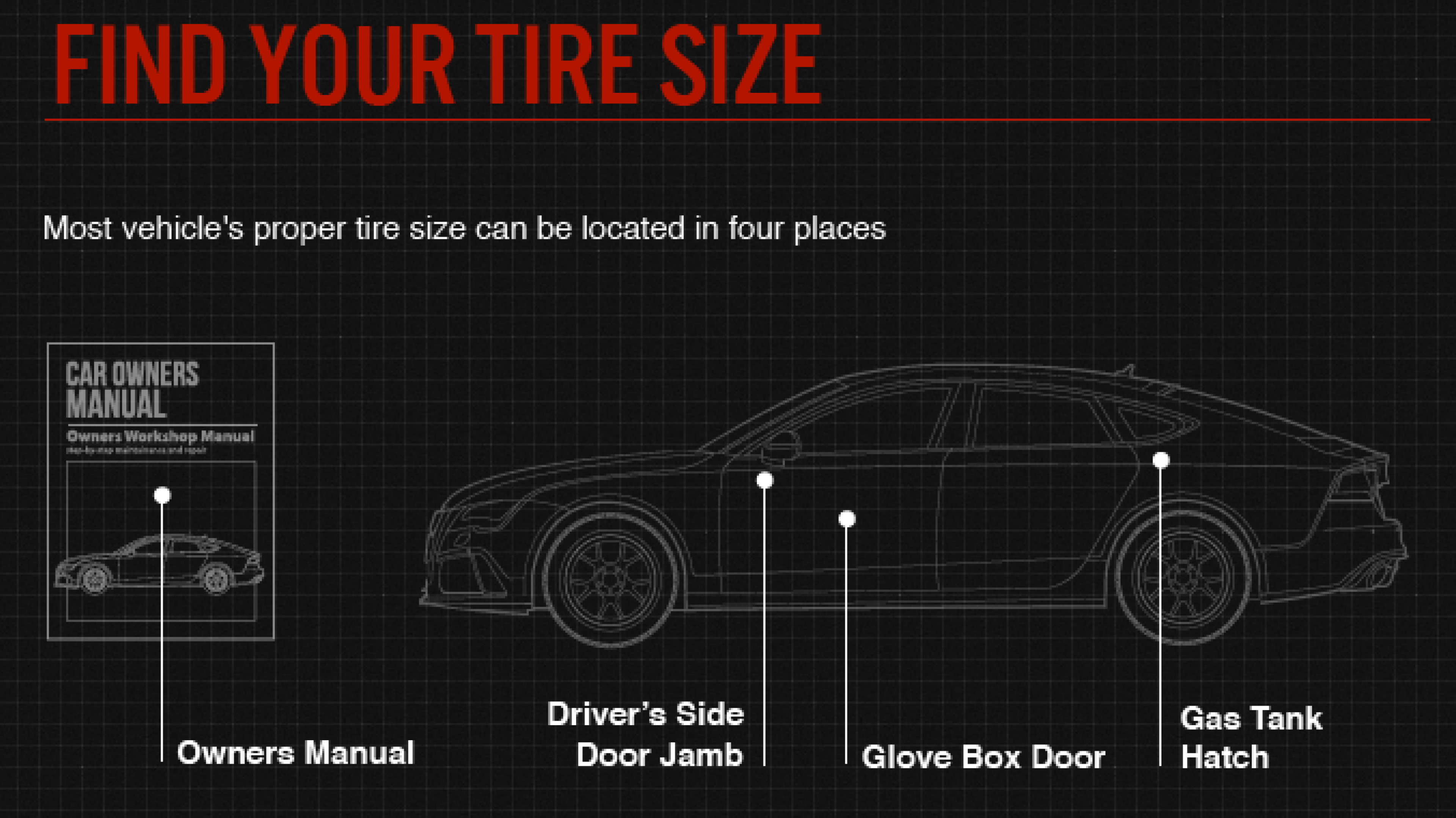Tire Maintenance & Safety
Free shipping
Best price guarantee
Special pricing
Financing with Resolve
Easy returns

Choosing the right tire size for your vehicle is a critical decision that impacts safety, performance, and fuel efficiency. Understanding the various numbers and letters on your tire sidewall can be confusing, especially for those new to tire buying.
To help simplify the process, we'll break down the meaning behind each part of the tire size code. By the end of this article, you'll be equipped with the knowledge to confidently select the perfect tires for your car, truck, or SUV.
Let's start by deciphering the seemingly cryptic string of characters that make up a tire size, such as 205/55R16 91V. Each component plays a vital role in determining the tire's dimensions, capabilities, and compatibility with your vehicle.
What do the numbers on tires mean?

At first glance, a tire size like 205/55R16 91V may appear to be a random assortment of numbers and letters. However, each element provides essential information about the tire's key characteristics:
- Tire width: The first number, 205, represents the tire's width in millimeters from sidewall to sidewall. This measurement directly impacts the tire's contact patch with the road, affecting handling, traction, and ride comfort.
- Aspect ratio: The second number, 55, is the tire's aspect ratio—the height of the tire's cross-section as a percentage of its width. A lower aspect ratio (e.g., 50) indicates a shorter sidewall and sportier handling, while a higher aspect ratio (e.g., 75) offers a taller sidewall and a more comfortable ride.
- Construction type: The letter "R" stands for radial construction, which is the most common type of tire design. Radial tires provide improved fuel efficiency, longer tread life, and better road grip compared to older bias-ply tires.
- Wheel diameter: The last number, 16, denotes the diameter of the wheel rim in inches. It's crucial to choose tires that match your vehicle's wheel size to ensure proper fitment and performance.
In addition to these main components, you'll also find the load index and speed rating at the end of the tire size code. The load index, 91 in this example, indicates the maximum weight the tire can support when properly inflated. The speed rating, denoted by the letter "V," represents the maximum speed at which the tire can safely operate.
By understanding each element of the tire size, you can make informed decisions when selecting tires that meet your vehicle's specifications and your driving needs. Tools like tire size calculators, which you can find at trusted online retailers such as SimpleTire, can help you quickly determine the right size based on your vehicle's make and model.
Why is it important to choose the right tire size?
Choosing the right tire size is vital for maintaining road safety. Tires are the sole connection between your vehicle and the road surface, crucial for effective handling and braking. Using an incorrect tire size can reduce traction, resulting in extended stopping distances and decreased stability, especially under challenging weather conditions. The correct tire size ensures your vehicle performs as intended, enhancing your safety while driving.
Beyond safety, selecting the right tire size influences vehicle performance and fuel efficiency. Mismatched tire sizes can disrupt gear ratios, leading to higher fuel consumption. This can also place unnecessary stress on the engine and transmission, potentially shortening their lifespan. Furthermore, the correct size guarantees a proper fit on the wheel, avoiding any contact with suspension components—preventing early tire wear or damage.
It is essential to understand the tire information placard, usually found on the driver's side door jamb or in the vehicle’s manual. This placard lists the manufacturer's recommendations for tire size, load capacity, and optimal tire pressure. Sticking to these specifications ensures your vehicle operates at peak efficiency, balancing comfort, and performance. Consulting these resources when buying new tires helps prevent costly errors and maximizes your vehicle's potential.
How to find your vehicle's tire size

Locating the right tire size for your vehicle begins with examining the sidewall of your current tires. Here, you'll find crucial details such as the size, load index, and speed rating—all necessary for ensuring your new tires match the original specifications.
Beyond the tire itself, check your vehicle’s documentation for tire size details. This information can often be found on a label situated in the driver's side door jamb, within the glove box, or noted in the owner’s manual. This label not only specifies the correct tire dimensions but also advises on optimal inflation pressure and maximum load limits.
For a more modern solution, consider using SimpleTire to find your tire size. Many websites offer tire size guides where you can input your vehicle's make, model, and year to swiftly identify the appropriate size. This method is particularly beneficial if your vehicle's physical documentation is unavailable—ensuring you select tires that fulfill your vehicle’s design and performance criteria.
What is the difference between metric and LT tire sizes?
Grasping the difference between metric and LT (Light Truck) tire sizes is key to choosing the appropriate tires for your vehicle's unique requirements. Metric tire sizing, typically found on passenger vehicles, follows a format like 225/70R16. This system emphasizes a comfortable ride, efficient handling, and better fuel economy—perfect for everyday driving on smooth surfaces. Metric tires offer a quiet ride while focusing on energy efficiency and traction.
On the other hand, LT tires are crafted for the demands of trucks, SUVs, and vehicles used for heavy-duty tasks or off-road excursions. These tires are marked with the "LT" prefix, indicating their design for carrying heavier loads. LT tires are built with reinforced sidewalls and sturdy internal structures, making them suitable for towing, hauling, and traversing rugged terrains. They are designed to handle higher inflation pressures needed to support extra weight.
Deciding between metric and LT tires involves considering the type of vehicle, its typical usage, and load needs. For cars and vehicles primarily used on highways or urban roads, metric tires provide the best balance of comfort and efficiency. However, if your vehicle frequently encounters rough conditions, carries substantial loads, or goes off the beaten path, LT tires offer the necessary durability and strength. Always consult your vehicle's specifications to ensure you're using the correct tire type for optimal performance and safety.
Understanding load index and speed rating
Beyond just the size of the tire, understanding the load index and speed rating is crucial for selecting tires that match your vehicle’s capabilities. These two ratings ensure that the tires can handle the weight and speed demands of your vehicle, contributing to overall safety and performance.
The load index, a number found on the tire, specifies the maximum weight each tire can handle when inflated to the recommended pressure. This is essential for maintaining vehicle stability and ensuring that the tire structure can support your vehicle’s weight. For instance, a load index of 91 correlates to a specific weight capacity, allowing you to calculate the total weight your tires can manage collectively. Adhering to the recommended load index by your vehicle manufacturer prevents issues like excessive strain on the tires and potential tire failure.
Equally important is the tire’s speed rating, indicated by a letter, which corresponds to the highest speed the tire can maintain while performing safely. This rating is vital for ensuring that the tire can handle the speeds your vehicle might reach under typical driving conditions. For example, a tire with a "V" rating can safely manage speeds up to 149 mph. Choosing tires with an appropriate speed rating ensures that your vehicle operates efficiently and safely, aligning with its designed performance capabilities.
Mixing tire sizes: Is it safe?
Combining different tire sizes on a vehicle can lead to various complications that affect both safety and performance. When tires are not uniform, it can cause irregular tread wear, which diminishes tire lifespan and escalates replacement costs. More importantly, mismatched tires can alter the vehicle's handling dynamics—compromising stability during turns and sudden maneuvers.
Using tires of varying sizes on the same axle disrupts the vehicle's balance, affecting steering precision and potentially creating hazardous driving conditions. This imbalance may also skew speedometer and odometer readings, as these instruments depend on consistent tire dimensions for accuracy. Such inconsistencies can lead to misjudgment of speed, posing a risk of unintentional speeding.
If circumstances necessitate the use of different tire sizes, such as employing a temporary spare or facing limited availability, it's important to minimize risks. Ensure that tires of the same size remain on each axle to maintain balance and alignment, providing a more stable driving experience. This measure should only serve as a short-term solution until all four tires can be replaced with a matching set, ensuring consistent performance and safety.
How to choose the right tire size for your needs

Selecting the ideal tire size involves assessing your typical driving scenarios, environmental conditions, and the specific demands of your vehicle. Urban drivers, who primarily navigate city streets, should focus on tires that enhance fuel efficiency and ride comfort, providing a smooth experience on paved roads. For those who frequently travel on uneven or off-road terrains, tires with reinforced sidewalls and aggressive tread patterns will ensure better durability and traction.
Engaging with a knowledgeable tire professional can provide insights tailored to your unique requirements. These experts can recommend tires that align with both your vehicle’s specifications and your driving style. Additionally, online tools offer a convenient way to explore compatible tire options by entering your vehicle's make, model, and year. This approach simplifies the selection process, ensuring you find tires that fit your vehicle and fulfill your performance needs.
When contemplating a change in tire size, it’s crucial to understand the implications. Opting for a larger tire size might require adjustments to your vehicle's suspension or body to fit the new dimensions. Larger tires can offer enhanced traction and an appealing look but may affect your speedometer reading and fuel consumption. Conversely, downsizing could improve fuel economy but at the cost of compromised handling and safety. Sticking to the manufacturer's recommended tire size ensures your vehicle maintains optimal performance, balancing safety, comfort, and efficiency.
Choosing the right tire size is essential for ensuring a safe, comfortable, and efficient driving experience. By understanding the various components of tire size and considering your specific needs, you can make an informed decision when selecting tires for your vehicle. If you're looking for a convenient way to find the perfect tires at competitive prices, visit us at SimpleTire, where we make it easy for you to shop for tires online and find the best deals.
Ready to find the perfect tires?
Search By